Reclaimed wood furniture isn’t just stylish; it’s stronger and more sustainable than new wood. Old-growth fibers and natural aging give it remarkable durability and character, with unique markings and textures from its past lives. Sourced from barns, industrial sites, or shipwrecks, each piece carries history and eco-friendly benefits—reducing waste and deforestation. But uncovering its full potential means understanding its processing, challenges, and unmatched charm. If you keep exploring, you’ll discover all the untold truths behind this timeless material.
Key Takeaways
- Reclaimed wood furniture boasts superior strength and stability due to dense, aged fibers, making it more durable than new lumber.
- Each piece tells a unique story through markings, weathered textures, and historical origins, adding authentic character.
- Proper processing, including de-nailing and kiln drying, ensures safety, prevents warping, and enhances aesthetic appeal.
- Sourcing challenges and higher costs stem from limited availability, variability, and the need for thorough inspection and treatment.
- Eco-friendly and sustainable, reclaimed wood reduces deforestation, extends resource lifespan, and supports environmentally conscious design.
The Strength and Durability of Reclaimed Wood
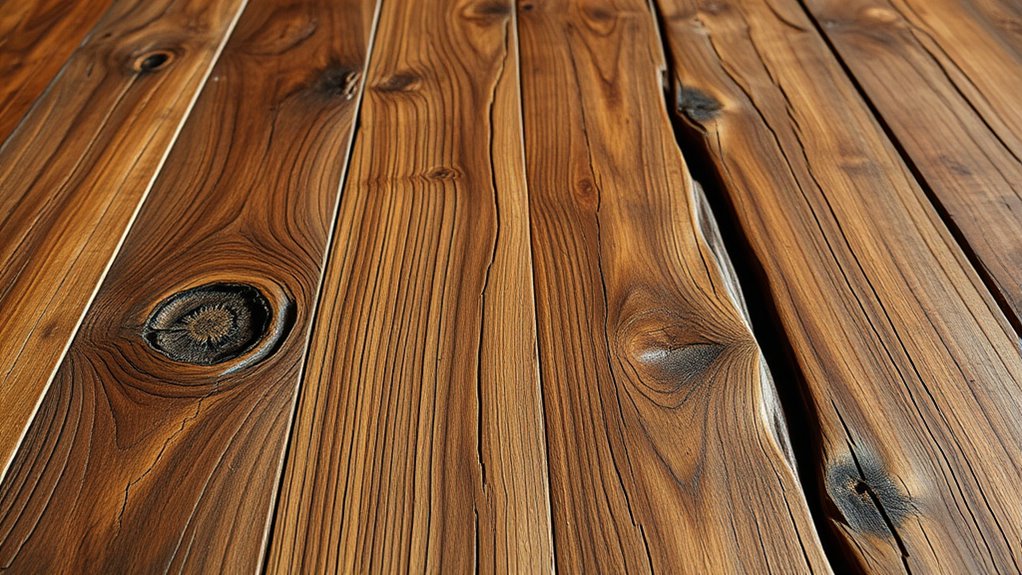
Reclaimed wood often surpasses new lumber in strength because its dense, old-growth fibers develop over many years. This aging process results in superior stability and durability, making reclaimed wood highly resistant to warping and cracking. Its old-growth composition features thicker internal fibers that improve load-bearing capacity, ensuring it can support heavy weight over time. Proper treatment and kiln drying further enhance its strength by removing moisture and pests, maintaining structural integrity for furniture and flooring. Studies show reclaimed wood can be up to 30% stronger than comparable new wood, thanks to its dense cellular structure. Additionally, electric power generation with bike generators demonstrates how durable materials like reclaimed wood can be effectively utilized in sustainable projects. When combined with eco-friendly manufacturing practices, reclaimed wood’s durability and sustainability make it an increasingly popular choice for environmentally conscious consumers. Its moisture content and proper seasoning are crucial factors that contribute to its long-term strength and stability. Properly seasoned reclaimed wood’s resistance to warping and cracking further enhances its reliability over time. As a result, reclaimed wood offers exceptional strength and durability, making it a reliable choice for long-lasting, load-bearing applications. Moreover, understanding the aging process of reclaimed wood can help optimize its use in various projects.
Unique Aesthetic and Historical Significance
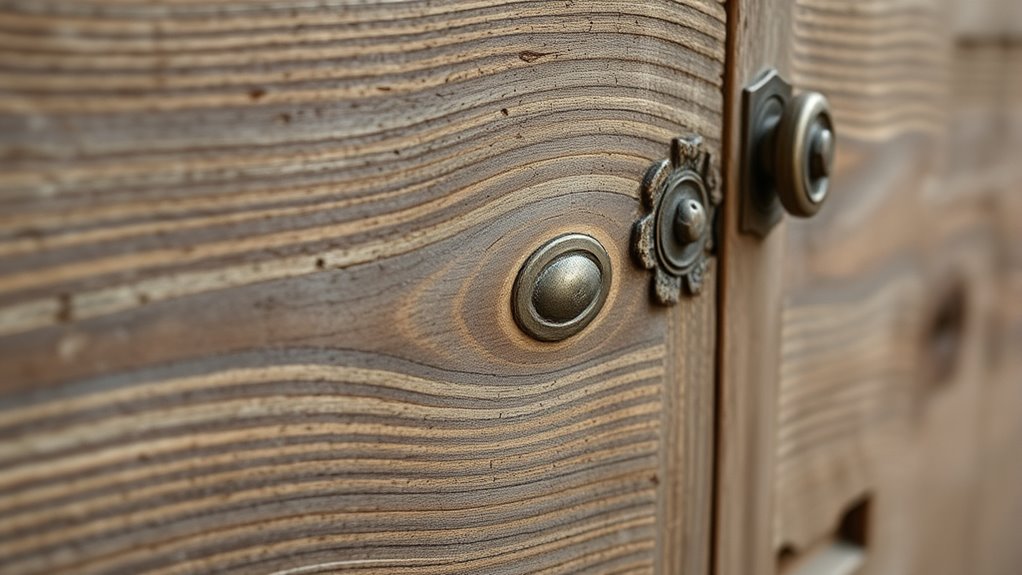
The distinctive markings, nail holes, and weathered textures found in reclaimed wood tell compelling stories of its past lives, adding authentic character to every piece. When you choose reclaimed wood, you embrace its unique character rooted in its historical origins—whether from barns, factories, or ships—each contributing a distinct aesthetic. The aged appearance of reclaimed wood offers a timeless, rustic charm that enhances your furniture’s visual appeal. These design elements celebrate history, connecting you to craftsmanship from bygone eras. Incorporating reclaimed wood preserves cultural heritage while creating pieces with genuine authenticity. Its natural patina and weathered textures serve as tangible links to the past, elevating your furniture with a rich, textured aesthetic that’s both stylish and meaningful. Additionally, understanding the types of reclaimed wood can help you select the most suitable material for your projects. Recognizing the environmental benefits of reclaimed wood can also reinforce your commitment to sustainable design choices. Moreover, proper SQA best practices in quality assurance during the selection and crafting process ensure the durability and craftsmanship of reclaimed wood furniture.
Common Sources and Types of Reclaimed Timber
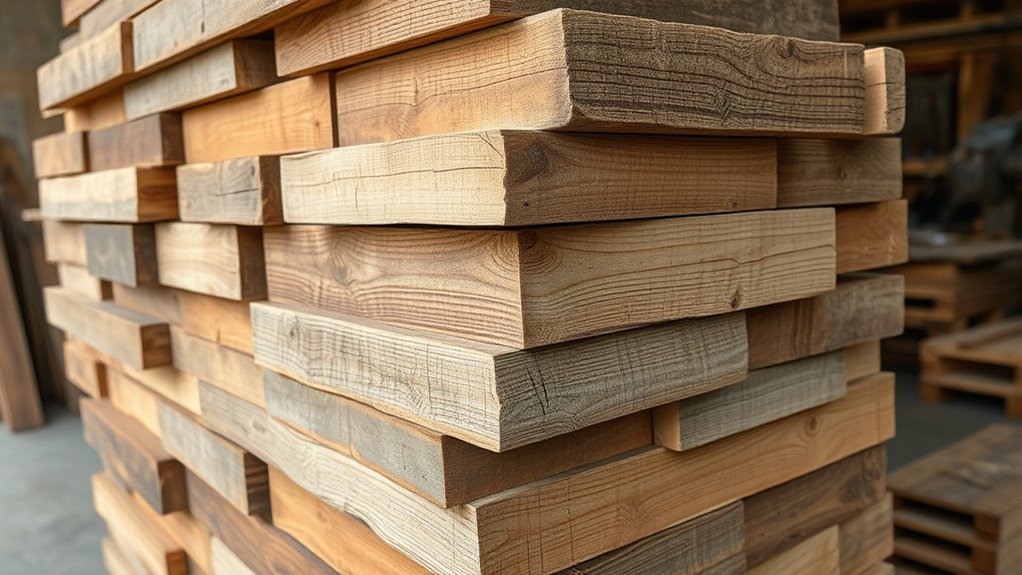
You’ll find reclaimed timber from old barns, farms, and industrial buildings, each adding unique character to your furniture. Maritime and sunken logs also provide rare, exotic options with a rich history. The age and origin of the wood influence its strength and appearance, making every piece one-of-a-kind. Additionally, understanding toilet maintenance and repairs can help preserve the integrity of reclaimed wood furniture by preventing damage from moisture or pests. Proper wood treatment techniques are essential to maintain its durability and beauty over time. Recognizing the distinctive features of reclaimed wood, such as grain patterns and color variations, can further enhance your appreciation of these sustainable materials. Exploring sustainable building materials like reclaimed wood can also contribute to eco-friendly design choices that benefit the environment, especially when considering the cost-effectiveness of reclaimed materials over newer options.
Old Barns and Farms
Old barns and farms serve as prime sources of reclaimed timber, offering centuries-old wood with exceptional durability and character. This weathered wood, often from old farms, features rich patina, nail holes, and saw marks that add rustic charm to reclaimed wood furniture. These structures typically used high-quality hardwoods like oak, chestnut, and redwood—rare finds today. The age and exposure to the elements increase the wood’s stability, resistance to warping, and unique aged appearance. Reclaimed timber from old barns and farms is highly sought after for sustainable projects that emphasize character and history. Moreover, the historical use of seeds of these structures contributed to their resilience and distinctive features over time. The environmental benefits of using reclaimed wood make it an eco-friendly choice for conscious consumers. Additionally, the long-lasting nature of these woods ensures that furniture made from reclaimed materials can be enjoyed for generations. Below is a visual of common sources and types:
| Source | Key Characteristics |
|---|---|
| Old barns | Weathered, nail holes, saw marks, rustic charm |
| Old farms | Dense hardwoods, aged patina |
Industrial Building Demolition
When industrial buildings are demolished, they often yield large quantities of reclaimed timber that can be repurposed for furniture and flooring. This process, known as industrial building demolition, provides access to reclaimed hardwood such as oak and Douglas fir, which develop weathered surfaces and industrial wear marks over time. These structural components, like beams and planks, are dense, stable, and highly durable, making them ideal for various applications. However, embedded metal fasteners, nails, and hardware are common and require careful removal before reuse. The weathered surface and industrial wear marks give each piece a distinctive character, showcasing the history of its original environment. This reclaimed timber not only offers unique aesthetic qualities but also promotes sustainable furniture-making practices.
Maritime and Sunken Logs
Maritime reclaimed wood primarily comes from sunken logs and shipwrecks that have been preserved underwater, where the marine environment slows decay and enhances durability. Sunken logs, often from ancient forests, are prized for their dense, stable wood, making them highly desirable for furniture and decorative pieces. Marine reclaimed wood, including shipwreck timber, exhibits unique weathered textures and rich coloration caused by prolonged exposure to saltwater and marine conditions. These submerged sources can be centuries old, sourcing exotic woods like teak and mahogany from floodplains or riverbeds. Underwater preservation prevents rot and pest damage, resulting in reclaimed timber with exceptional strength, character, and a distinctive marine aesthetic. This makes maritime reclaimed wood a rare and valuable material for craftsmanship. Additionally, sustainable sourcing of these materials aligns with eco-friendly travel principles by repurposing naturally fallen or sunken timber instead of harvesting new forests.
Processing and Treatment Methods
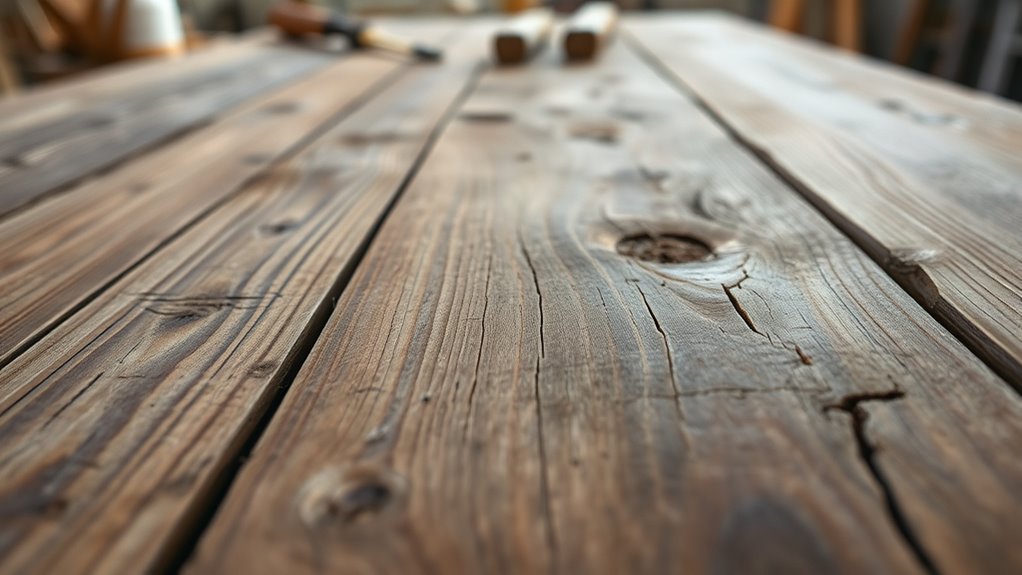
Processing and treatment of reclaimed wood involve a series of careful steps to guarantee safety, stability, and aesthetic appeal. First, you’ll de-nail and remove any metal fragments through de-nailing and metal detection, ensuring the wood is safe for further processing. Next, the wood is kiln-dried to reduce moisture content to 6-9%, which helps prevent warping and cracking. Milling transforms the reclaimed wood into uniform dimensions, while sanding smooths the surfaces for a refined finish. Additional treatments may include wire brushing or sealing to enhance appearance and durability. Some reclaimed wood is chemically treated or stained to achieve specific colors or finishes, depending on your design goals. These meticulous methods ensure the reclaimed wood is both beautiful and stable for furniture making. Proper processing also involves wood preservation techniques to extend the lifespan of the finished furniture, and incorporating environmentally friendly treatments can further enhance sustainability and safety. Implementing moisture control methods during processing is also crucial to maintaining the wood’s stability over time, especially considering the importance of climate considerations in preserving reclaimed wood’s integrity.
Environmental Advantages and Conservation Impact
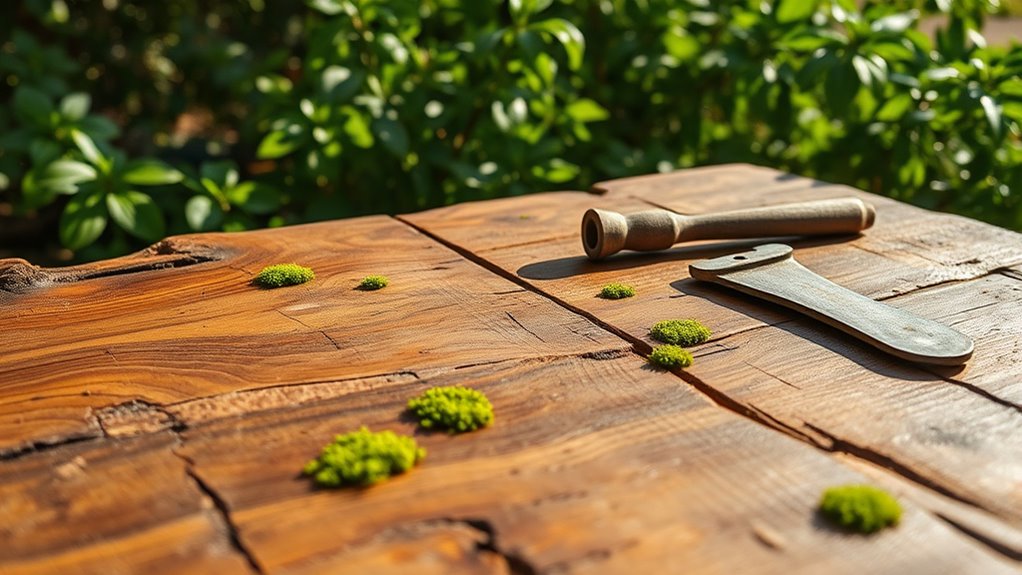
Choosing reclaimed wood helps you reduce deforestation by reusing existing materials instead of cutting down new trees. It also keeps waste out of landfills, preventing harmful methane emissions. By supporting these practices, you contribute to forest conservation and a more sustainable future.
Reduces Forest Deforestation
Reclaimed wood furniture plays a pivotal role in reducing forest deforestation by lowering the demand for new timber. When you choose reclaimed wood, you’re actively helping to prevent deforestation and protect natural habitats. This practice extends the lifespan of existing wood resources, decreasing the need to cut down more trees. It’s an environmentally friendly option that minimizes the environmental impact associated with logging and processing new lumber. Additionally, recycling wood from old structures reduces wood waste in landfills, supporting broader conservation efforts. Supporting reclaimed wood furniture also encourages sustainable forestry practices and helps combat illegal logging. By making conscious choices, you contribute to preservation efforts and promote a more sustainable balance between human needs and forest health.
Promotes Sustainable Practices
Opting for reclaimed wood furniture directly supports sustainable practices that benefit the environment. By repurposing old wood, you help reduce deforestation and protect old-growth trees. This eco-friendly choice also lowers energy consumption since processing reclaimed wood takes less energy than producing new lumber. Recycling wood from existing structures prevents it from landfills, cutting methane emissions and conserving resources. Supporting reclaimed wood promotes forest conservation by decreasing demand for endangered species and exotic woods. Your decision aligns with sustainable development goals, fostering environmentally responsible practices.
| Benefits of Reclaimed Wood | Impact on Sustainability |
|---|---|
| Reduces deforestation | Preserves old-growth trees |
| Lowers energy use | Decreases carbon footprint |
| Supports forest conservation | Prevents demand for endangered woods |
| Prevents waste in landfills | Mitigates methane emissions |
| Promotes eco-friendly practices | Encourages sustainable development |
Practical Uses in Interior Design and Furniture
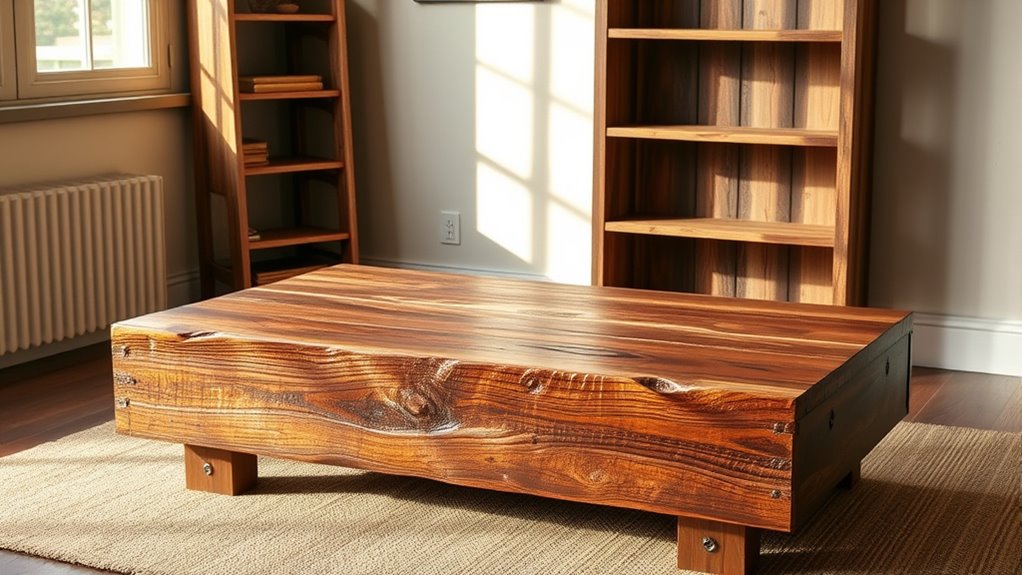
Reclaimed wood’s natural character and durability make it an excellent choice for various interior design applications. You’ll find reclaimed wood furniture, like dining tables, headboards, and benches, adding unique imperfections and historic charm to your space. Reclaimed wood flooring offers a durable, weathered surface with striking grain patterns that enhance rustic or industrial aesthetics. It’s also perfect for accent walls and ceiling panels, creating textured focal points that tell a story. Its versatility allows it to blend seamlessly with modern, farmhouse, or eclectic styles. Plus, choosing reclaimed wood supports eco-friendly practices and sustainable design. Whether you’re crafting custom furniture pieces or transforming your interiors, reclaimed wood provides both practicality and visual appeal, making your space warm, inviting, and environmentally conscious.
Challenges and Considerations When Sourcing and Working With Reclaimed Wood
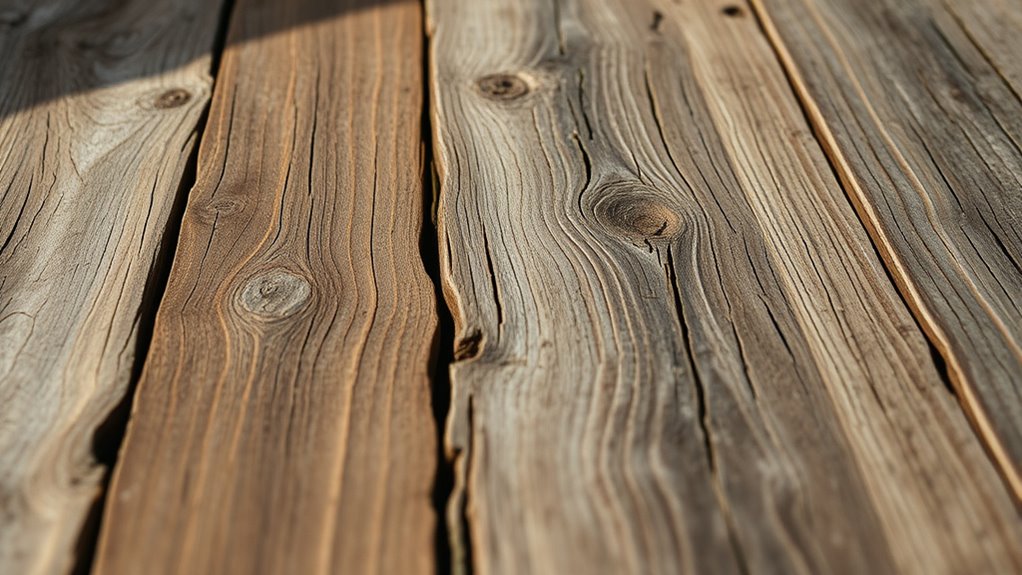
While reclaimed wood offers unique aesthetic and environmental benefits, sourcing and working with it can present several challenges. Hidden defects like internal rot, insect damage, or weakened fibers may not be visible at first, risking structural issues during installation. Metal detection is vital to identify old nails, screws, and fragments, ensuring safety and preventing tool damage. Limited availability and sourcing reclaimed wood can lead to higher costs and longer lead times, especially for specific types or quantities. Additionally, the wood often varies in size, shape, and thickness, requiring extra processing like cutting and sanding for uniformity. Ensuring quality verification and working with reliable suppliers are essential steps to avoid inconsistencies and guarantee sustainable, safe use of reclaimed wood.
Frequently Asked Questions
What Are the Disadvantages of Reclaimed Wood?
You might wonder about the disadvantages of reclaimed wood. It can contain hidden defects like rot, insect damage, or weakened fibers that compromise its strength. The irregular shapes and sizes often mean extra work and costs for customization. Safety hazards like nails or metal fragments can damage tools or cause injuries. Plus, limited availability and variable quality can lead to higher prices and sourcing delays.
Is Reclaimed Wood Furniture Good Quality?
You’ll find that reclaimed wood furniture is generally high quality because it comes from old-growth trees with dense, durable fibers. Its aging process enhances stability, making it less likely to warp or crack. Skilled craftsmen inspect and treat the wood carefully, ensuring it’s free of pests and decay. Plus, the unique weathered textures and knots add character, giving you a strong, beautiful piece that often surpasses new wood in durability.
How to Get Reclaimed Wood for Free?
Getting reclaimed wood for free is like catching lightning in a bottle. You can start by reaching out to local demolition sites, salvage yards, or construction companies—they often have leftover wood they’re happy to give away. Also, join community cleanup or deconstruction events where materials are donated. Check online marketplaces or social media groups for free postings, and contact historical societies or recycling centers—they frequently donate reclaimed wood to promote sustainability.
How Long Does Reclaimed Wood Last?
Reclaimed wood can last for decades or even centuries if you take good care of it. Its dense, old-growth fibers resist warping, cracking, and decay, making it highly durable. With proper kiln drying, cleaning, sealing, and routine maintenance like refinishing, your reclaimed wood furniture can stay beautiful and functional for generations. You’ll want to stay proactive in caring for it to guarantee it continues to stand the test of time.
Conclusion
Think of reclaimed wood as a storybook, each piece holding tales of the past. When you incorporate it into your space, you’re not just adding furniture—you’re preserving history and embracing sustainability. Just like an ancient tree standing tall through storms, reclaimed wood offers strength and character. By choosing it, you’re becoming part of a legacy that blends craftsmanship with conservation, creating a space that’s both beautiful and meaningful.









